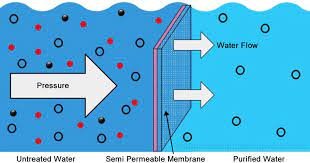
Leveraging Osmosis: Engineered Membrane Processes for Sustainable Water Treatment

As water scarcity intensifies globally, innovative technologies are needed to ensure adequate supply and optimize treatment. Water processes based on osmosis, the natural diffusion of water across a semi-permeable membrane, have generated growing interest for their efficiency, reliability, and environmental sustainability. Engineered osmosis methods like forward osmosis (FO) and pressure-retarded osmosis (PRO) utilize optimized membranes to harvest osmotic energy and recover water, showing promise to reduce costs and energy consumption in desalination, wastewater reuse, and power generation.
Understanding Osmosis
Osmosis results when a membrane separates solutions of differing solute concentrations, with net movement of water molecules towards the more concentrated solution. This flow generates osmotic pressure, a renewable energy source extractable by engineered processes. FO and PRO apply controlled osmosis mechanisms for valuable purposes like capturing water from waste streams too contaminated for treatment by regular reverse osmosis.
Engineered FO Extracts Water from Challenging Sources
In FO, diluted feed solution flows alongside a concentrated solution called the draw solution, separated by a specialized semi-permeable membrane. Net water transport as osmosis occurs from the feed into the draw solution. Efficiencies are increased using draw solutions with higher osmotic pressures, optimized often using soluble salts. The now diluted draw solution then undergoes a separation process, typically membrane-based, to extract pure water and regenerate the draw solutes for reuse.
FO enables water recovery from impaired sources like seawater, municipal wastewater, and industrial effluent. Contaminant rejection rates are higher than traditional processes like microfiltration without fouling from particulates, colloids, and organics. This allows wastewater constituent preconcentration and volume reduction using far less energy input. FO thus offers an excellent pretreatment or alternative for high salinity brines and biosolids streams. It can extract water from complex sources for cooling tower operations, agriculture, or groundwater recharge.
PRO Generates Electricity from Salinity Gradients
Pressure-retarded osmosis utilizes saline and freshwater sources on each side of a semi-permeable membrane. Pressurizing the saline solution arrests net flow towards the freshwater side while allowing water transport as osmosis. The pressurized diluted saline solution drives a hydro turbine for electrical power generation.
Rivers flowing into seas offer PRO-accessible salinity gradients. Estimates suggest osmotic power production could meet up to 13% of today’s energy needs. Further optimization for commercial applications regarding membranes and systems engineering is ongoing. PRO helps simultaneously address freshwater contamination and renewable energy goals by deriving sustainable energy from wastewater or seawater flows requiring disposal.
 Advanced Membranes and Module Designs Improve Engineered Osmosis
Advanced Membranes and Module Designs Improve Engineered Osmosis
Recent advances in tailored membrane technology enable FO and PRO implementation for water treatment and energy generation. Key membrane attributes include high water permeability, salinity rejection, and chemical tolerance to fluxes and environment. Optimized two-dimensional layer and thin film composite (TFC) architectures allow efficient osmotic flow. Promising materials include cellulose derivatives, layered nanocomposites, and graphene oxides, offering excellent flux with mitigated fouling.
Novel membrane module configurations also enhance performance. Spiral-wound or capillary formats increase packing density. Hollow fiber designs stimulate turbulence while resisting concentration polarization. TFCs immobilized in 3D-printed frames leverage fabrication innovations and modeling. Targeted integration within existing infrastructure provides usable, scalable osmosis-based systems.
Future Trajectory Holds Promise for Sustainable Water Solutions
Research into engineered osmosis applications continues advancing. Recent techno-economic modeling indicates that FO-desalination and FO-reverse osmosis hybrid plants could soon become cost-competitive, producing potable water while recycling complex concentrate streams. PRO pilot projects signal a closer realization of osmotic power systems extracting energy from natural water cycles. Machine learning integration may soon optimize membrane fouling, cleaning, and replacement control based on stream characteristics. Further funding and field testing will refine implementation roadmaps leveraging osmosis dynamics for water production and renewable energy generation.
Conclusion
Given appropriate innovations in membrane materials and system configurations, natural osmosis mechanics can directly enable progress on integrated water and energy sustainability goals. Engineered forward osmosis reliably recovers unusable water from challenging contaminated sources. Pressure-retarded osmosis generates consistent carbon-free electricity from salt concentration differences between wastewater and seawater. With improved manufacturing and modeling techniques, engineered osmosis capacities could soon scale up to provide necessary process water reuse and clean energy. With expanded deployment, engineered osmosis technologies hold a unique promise to help secure water, food, and power access for all on local and global levels against worsening scarcity challenges.
